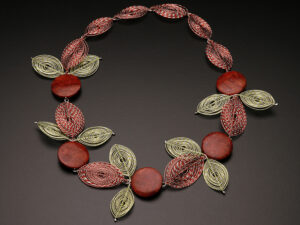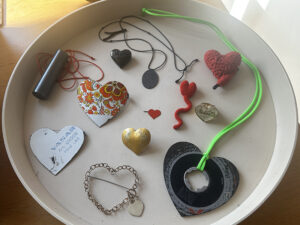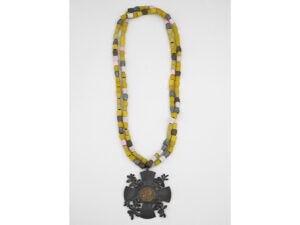Individuals have as many reasons to buy and/or collect objects as there are objects available. Jewelry is one of the more personal passions in collecting due to its connection to our bodies. After all, most objects cannot be presented to the world on a daily basis in such an intimate manner as jewelry. We present a little of ourselves with each brooch or necklace worn.
Individuals have as many reasons to buy and/or collect objects as there are objects available. Jewelry is one of the more personal passions in collecting due to its connection to our bodies. After all, most objects cannot be presented to the world on a daily basis in such an intimate manner as jewelry. We present a little of ourselves with each brooch or necklace worn.
Generally, there comes a time in the lives of collectors to consider sharing pieces of our passion with the rest of the world through donations to museums and other institutions, thus promoting jewelry as an art form. This desire to give back is innate in most of us, even if we have varying secondary reasons attached to our giving. AJF is undertaking a project to provide a primer to inform interested collectors in navigating the process of donation. I have been asked to begin by providing some basic information that identifies the delights and pitfalls associated with the process.
In the spirit of full disclosure, I have not yet been successful in donating jewelry to an institution. I have, however, donated pieces from our contemporary ceramics collection to museums for the past five years. It has been extremely rewarding, but I must tell you that I had been trying to donate work for ten years prior to our first success! This hints at why AJF wants to prepare you for – and lead you through – the forest. Believe it or not, it may be difficult to give your jewelry away. In celebration of your generosity, I present six lessons for your desire to share.
Lesson One: Critically Assess Your Gift
The first step to success is to realize that there are many differences between personal collections and public collections. As in all aspects of life, there is never consensus. One size does not fit all and a beautiful piece of jewelry that adorns your body so specially may have no place in the curatorial agendas of an institution. This is especially true for jewelry because one of the key components in the personal collection, the connection to the body, will never be duplicated in a museum setting. The extension of yourself that jewelry provides is not possible in an institutional exhibit. It is critical for you to gain the objectivity to look at your pieces with a museum’s eye. You can begin by looking critically at a museum’s collection, reading its curatorial statements and by speaking to others who have been successful in lending or donating to the institution.
Lesson Two: Do Your Homework
Once you believe that you have jewelry that might delight a curator or director of a museum, begin to research your options by looking at various public collections for a good fit. Is the museum focusing on historical jewelry and ‘light’ on contemporary examples? Is the institution wed to jewelry only from Western Europe? Is the museum strong in some areas of decorative arts, design or craft, but not so in jewelry? There are many more appropriate questions than these examples, but you must ask them and others to ensure the best repository for your donation in order to succeed.
Lesson Three: Find the Niche
Armed with your research, speak to others who might have experience with various institutions. This information can save you a lot of time and potential disappointment. Someone may know things from experience that you will not find in the museum’s printed material. Realize that most times there is more than one ideal home for your donation. Start with your first choice and proceed. It is imperative that you answer the questions related to why you have made your choice. Do you only want your pieces in a large, nationally known institution? Do you particularly want your gifts confined to a particular region? Close to home? Or does the idea of helping build a strong collection in an institution just starting to expand its jewelry holdings appeal to you?
Lesson Four: Make a Connection
Once you have made your decision, contact the institution. You might start with a letter or e-mail of introduction to the appropriate curator or director. Share you passion and desire to enhance the museum’s jewelry collection. Tell them of your collection’s focus and tease them with images, if possible. Make it clear that you are looking to gift to the museum, unless you have other intentions. Ask for a face-to-face meeting at their convenience. Or invite them to see the work in your home. In short, convince them of your desire to donate and tell them why you have chosen to approach them in order to gauge their interest.
Lesson Five: Be Prepared
You know what they say about first impressions! Do not let yourself fall into the mind trap that a curator will gush about your intentions upon meeting you. After all, curators and directors are the stewards of the collection and they have seen a lot of work. Do expect courtesy and integrity and you won’t be disappointed. Even if your work is not felt to enhance a particular collection, a sensitive curator might lead you to another institution with a better fit.
Try not to have unrealistic expectations. The days of museums acquiring an entire collection are numbered. Try not to present an all-or-none condition for your gifts. Today, this may amount to the kiss of death. If you are sincere about a gift to a particular museum, play by their rules and limitations. The result just might be the placement of one or more of your pieces in the collection of your choosing.
Feel free to express your desires about your pieces. If having the work on exhibit is your primary goal, you must discuss this with the museum. Smaller museums may be able to accommodate this request better than the large museum. If you simply want to add to the institution’s collections without stipulations, you may be more successful in more venues.
Expect conditions for accepting the gift from the museum as well. An institution may ask for a monetary gift to maintain the collection or for support for the institution at large. I have known at least one museum that made a financial gift a condition for accepting the work. Let nothing surprise you.
Lesson Six: Finally . . .
Your work is not finished with the acceptance of the gift. Most institutions insist that the donor obtain an appraisal of fair market value. Rarely, a museum will undertake or share this requirement, so discuss it by all means. Certified appraisers for contemporary art jewelry are few. Appraisers may ask for a percentage of the fair market value as their fee, may give you a flat fee, or may negotiate other arrangements depending on several factors, including number of works to be appraised, ease of finding secondary market data or having to establish a comparative value based upon like work. Again, discuss your options. Please realize that the IRS has put the onus on the appraiser if there is any question concerning the legitimacy of the fair market value appraisal. An appraisal therefore becomes a significant legal document.
The appraiser may ask for a copy of the institution’s deed of gift of your donation as well as a letter of acceptance of the gift from the institution. The appraiser also will expect you to provide the following information: title, date, artist, dimensions, medium, provenance, how purchased, price paid, exhibition/publication history and whether the piece is unique or part of an edition. The IRS requires most of this information as well. There are tax benefits associated with gifts to non-profits, but specifics will need to be addressed by your accountant or tax filer depending on your tax liability.
After all the T’s have been crossed and the I’s dotted, the jewelry you have treasured will become part of a greater whole. It will now belong to all of us for our education and enjoyment. There is a great sense of accomplishment and pride associated with being able to share one’s good fortune with others. Although the process can be daunting at times, the rewards are great. Sharing your jewelry with new eyes fosters better understanding and appreciation of the field we have chosen to love. By all means be generous. What better way to give a part of yourself to posterity?




